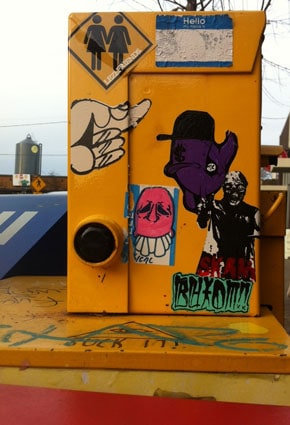We’re back with another round of some curious, provocative, amusing, and frightening observations that come from our daily experiences as researchers and as consumers.
Our second guest post of Curating Consumption came out last week over at Johnny Holland. In case you missed it over there, you can sit back and relax and enjoy it right here on our blog! In our first digest (Curating Consumtpion #1) we featured images from our travels to Austin, New York City and Dublin. This month we are looking much closer to home and finding ponderous interactions and objects within a few miles (and sometimes feet) of our front doors.
 My local cafe offers a small selection of lovely creams and lotions on the back of the toilet tank. I react thusly: “Ewwwww.” It’s one thing to put this in your home bathroom, or maybe in your office, where there’s a known and finite set of users. But this is a cafe along the highway. You don’t know who else has been using it, touching it, or not-washing-their-hands-and-touching-it! Or worse, I’ve seen some of the people that come in there and I do know who’s been touching it. Suffice to say that I do not want to be sharing cosmeceuticals with them! It’s the tragedy of the commons in the coffeeshop toilet. /SP
My local cafe offers a small selection of lovely creams and lotions on the back of the toilet tank. I react thusly: “Ewwwww.” It’s one thing to put this in your home bathroom, or maybe in your office, where there’s a known and finite set of users. But this is a cafe along the highway. You don’t know who else has been using it, touching it, or not-washing-their-hands-and-touching-it! Or worse, I’ve seen some of the people that come in there and I do know who’s been touching it. Suffice to say that I do not want to be sharing cosmeceuticals with them! It’s the tragedy of the commons in the coffeeshop toilet. /SP
 The fitting rooms in Old Navy have labelled hooks to assist you in categorizing your prospective purchases. It’s what we do when trying on clothes anyway, and while it’s not a complete solution (e.g., where’s the place to put the clothes you are already wearing?), there’s something charming about how it acknowledges your process. Also, those arrows bring a real dynamic energy to a static aspect of the task. Small details, but fun. /SP
The fitting rooms in Old Navy have labelled hooks to assist you in categorizing your prospective purchases. It’s what we do when trying on clothes anyway, and while it’s not a complete solution (e.g., where’s the place to put the clothes you are already wearing?), there’s something charming about how it acknowledges your process. Also, those arrows bring a real dynamic energy to a static aspect of the task. Small details, but fun. /SP

There is not a lot of graffiti in the tiny town of Pacifica, CA where Portigal Consulting calls home. I passed this while walking from the office to the ocean one day and felt annoyed, but not because of the graffiti itself. I like to think I am an enlightened urbanite who appreciates the aesthetic enhancement, self-expression, and community color that street art affords. In this case, however, I was pissed off by the placement. See that ugly grey brick wall RIGHT BEHIND the fence? Yes, that’s the one; the unadorned, badly-in-need-of-anything-to-bring-it-to-life one. I can’t for the life of me figure out why the artist tagged the pretty white picket fence instead of the menacingly misfortunate wall. /TC
 I spotted this sad scene on the sidewalk in front of our office. First I thought of the little girl who lost her shoe and would be upset, perhaps even scolded by her mom. And then I thought about the mother, recalling my own mothering moments of frustration realizing that my son or I had lost something of his along the way. And then I thought of the 6 word story penned by Hemingway, “For Sale: baby shoes, never worn.” And then I waxed anthropomorphically about the shoe and her point of view. Yes, that little shoe looks like a lonely lady; one who has lost her sole mate. /TC
I spotted this sad scene on the sidewalk in front of our office. First I thought of the little girl who lost her shoe and would be upset, perhaps even scolded by her mom. And then I thought about the mother, recalling my own mothering moments of frustration realizing that my son or I had lost something of his along the way. And then I thought of the 6 word story penned by Hemingway, “For Sale: baby shoes, never worn.” And then I waxed anthropomorphically about the shoe and her point of view. Yes, that little shoe looks like a lonely lady; one who has lost her sole mate. /TC













 My local cafe offers a small selection of lovely creams and lotions on the back of the toilet tank. I react thusly: “Ewwwww.” It’s one thing to put this in your home bathroom, or maybe in your office, where there’s a known and finite set of users. But this is a cafe along the highway. You don’t know who else has been using it, touching it, or not-washing-their-hands-and-touching-it! Or worse, I’ve seen some of the people that come in there and I do know who’s been touching it. Suffice to say that I do not want to be sharing cosmeceuticals with them! It’s the
My local cafe offers a small selection of lovely creams and lotions on the back of the toilet tank. I react thusly: “Ewwwww.” It’s one thing to put this in your home bathroom, or maybe in your office, where there’s a known and finite set of users. But this is a cafe along the highway. You don’t know who else has been using it, touching it, or not-washing-their-hands-and-touching-it! Or worse, I’ve seen some of the people that come in there and I do know who’s been touching it. Suffice to say that I do not want to be sharing cosmeceuticals with them! It’s the  The fitting rooms in Old Navy have labelled hooks to assist you in categorizing your prospective purchases. It’s what we do when trying on clothes anyway, and while it’s not a complete solution (e.g., where’s the place to put the clothes you are already wearing?), there’s something charming about how it acknowledges your process. Also, those arrows bring a real dynamic energy to a static aspect of the task. Small details, but fun. /SP
The fitting rooms in Old Navy have labelled hooks to assist you in categorizing your prospective purchases. It’s what we do when trying on clothes anyway, and while it’s not a complete solution (e.g., where’s the place to put the clothes you are already wearing?), there’s something charming about how it acknowledges your process. Also, those arrows bring a real dynamic energy to a static aspect of the task. Small details, but fun. /SP
 I spotted this sad scene on the sidewalk in front of our office. First I thought of the little girl who lost her shoe and would be upset, perhaps even scolded by her mom. And then I thought about the mother, recalling my own mothering moments of frustration realizing that my son or I had lost something of his along the way. And then I thought of the
I spotted this sad scene on the sidewalk in front of our office. First I thought of the little girl who lost her shoe and would be upset, perhaps even scolded by her mom. And then I thought about the mother, recalling my own mothering moments of frustration realizing that my son or I had lost something of his along the way. And then I thought of the 















































